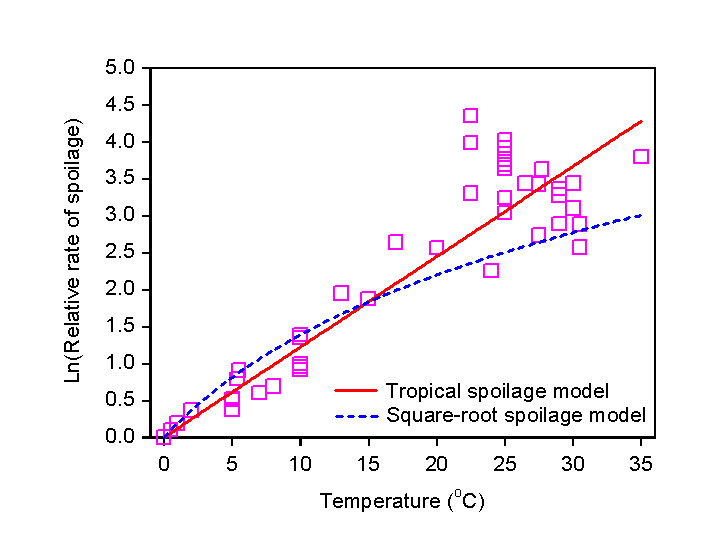|
|
| Model | Exponential model for relative
rate of spćoilage (RRS) of
fresh fish from warm/tropical waters |
| Reference | Dalgaard, P. and Huss, H.H. (1997). Mathematical
modelling used for evaluation and prediction of microbial fish spoilage. In Seafood
Safety, Processing and Biotechnology. Eds. Shahidi, F., Jones, Y. and
Kitts, D.D. Technomic Publishing Co. Inc., Lancaster. pp 73-89. |
| Factor(s) in model | Temperature |
| Range of applicability | Fresh seafood from tropical/warm waters stored
aerobically between 0°C and 30°C |
| Product validation studies: | |
| Aerobic and chilled storage | Carps, catla, longspine seabream, Lutjanus vittus/snapper-like, mackerel, milkfish, mullet, Nile perch, painted sweetlip, pearl spot, prawns, rabbit fish, rohu, sardine, seabream, shrimp, sole, tilapia, threadfin bream (Dalgaard and Huss, 1997; Dalgaard, 1999). |
|
The exponential spoilage model shown below is used in FSSP for the effect of temperature on RRS of fresh seafood from warm/tropical waters. To validate the model under fluctuating temperatures storage condition further studies are still needed. Ln(RRS) = 0.12 x T°C As shown in the Figure below, the simple exponential model was appropriate for the effect of temperature on average RRS-values of seafood from warm waters. Considerable scatter of the RRS data was observed at temperatures > 20°C and this is most likely related to difficulties of determining very short shelf-life periods precisely by sensory evaluations. |
 |
Relative rates of spoilage of fresh seafood form tropical waters. Modified from Dalgaard and Huss (1997) |